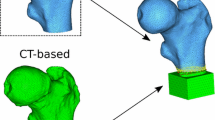Abstract
Measurement of bone mineral density (BMD) by dual-energy X-ray absorptiometry (DXA) alone is only a moderate predictor of fracture risk. Finite element analysis (FEA) of bone mechanics, based on DXA images, may improve the prediction of fracture risk. We developed a method to estimate the 3D shape and density distribution of the proximal femur, using a 2D BMD image and a femur shape template. Proximal femurs of eighteen human cadavers were imaged using computed tomography and divided into two sets (N = 9 + 9). The template was created from the samples in first set by using 3D generalized Procrustes analysis and thin-plate splines. Subsequently, the template and 2D BMD image were utilized to estimate the shape and internal density distribution of the femurs in the second set. Finally, FEA was conducted based on the original and the estimated bone models to evaluate the effect of geometrical and density distributional errors on the mechanical strength. The volumetric errors induced by the estimation itself were low (<1.4%). In the estimation of bones in the second set, the mean distance difference between the estimated and the original bone surfaces was 0.80 ± 0.19 mm, suggesting feasible estimation of the femoral shape. The mean absolute error in voxel-by-voxel BMD was 120±8 mg cm−3. In FEA, the stiffness of the proximal femur differed by −7±16% between the original and estimated bones. The present method, in comparison with methods used in previous studies, improved the prediction of the geometry, the BMD distribution and the mechanical characteristics of the proximal femur. Potentially, the proposed method could ultimately improve the determination of bone fracture risk.
Similar content being viewed by others
References
Bergmann G, Deuretzbacher G, Heller M et al (2001) Hip contact forces and gait patterns from routine activities. J Biomech 34: 859–871
Bookstein F (1989) Principal warps: thin-plate splines and the decomposition of deformations. IEEE Trans Pattern Anal 11: 567–585
Cody D, Gross G, Hou FJ et al (1999) Femoral strength is better predicted by finite element models than QCT and DXA. J Biomech 32: 1013–1020
Cootes TF, Edwards GJ, Taylor CJ (2001) Active appearance models. IEEE PAM 23: 681–685
Dragomir-Daescu D, OpDen Buijs J, McEligot S et al (2011) Robust QCT/FEA models of proximal femur stiffness and fracture load during a sideways fall on the hip. Ann Biomed Eng. 39: 742–755
Edwards W, Gillette J, Thomas J et al (2008) Internal femoral forces and moments during running: implications for stress fracture development. Clin Biomech 23: 1269–1278
Fang Q, Boas DA (2009) Tetrahedral mesh generation from volumetric binary and grayscale images. In: International symposium on biomedical imaging: from nano to macro. IEEE, Boston
Filippi S, Motyl B, Bandera C (2007) Analysis of existing methods for 3D modelling of femurs starting from two orthogonal images and development of a script for a commercial software package. Comput Meth Prog Biol 89: 76–82
Galibarov PE, Prendergast PJ, Lennon AB (2010) A method to reconstruct patient-specific proximal femur surface models from planar pre-operative radiographs. Med Eng Phys 32: 1180–1188
Gower J (1975) Generalized procrustes analysis. Psychometrika 40: 33–51
Humbert L, Whitmarsh T, De Craene M et al (2010) 3D reconstruction of both shape and bone mineral density distribution of the femur from DXA images. Biomedical imaging: from nano to macro, 2010 IEEE International Symposium on April 14–17, pp 456–459
Keyak J, Rossi S, Jones K et al (1998) Prediction of femoral fracture load using automated finite element modeling. J Biomech 31: 125–133
Keyak J, Rossi S, Jones K et al (2001) Prediction of fracture location in the proximal femur using finite element models. Med Eng Phys 23: 657–664
Keyak J, Falkinstein Y (2003) Comparison of in situ and in vitro CT scan-based finite element model predictions of proximal femoral fracture load. Med Eng Phys 25: 781–787
Kolta S, Le Bras A, Mitton D et al (2005) Three-dimensional X-ray absorptiometry (3D-XA): a method for reconstruction of human bones using a dual X-ray absorptiometry device. Osteoporos Int 16: 969–976
Kurazume R, Nakamura K, Okada T et al (2009) 3D reconstruction of a femoral shape using a parametric model and two 2D fluoroscopic images. Comput Vis Image Und 113: 202–211
Langton C, Pisharody S, Keyak J (2009a) Comparison of 3D finite element analysis derived stiffness and BMD to determine the failure load of the excised proximal femur. Med Eng Phys 31: 668–672
Langton C, Pisharody S, Keyak J (2009b) Generation of a 3D proximal femur shape from a single projection 2D radiographic image. Osteoporos Int 20: 455–461
Laporte S, Skalli W, De Guise J et al (2003) A biplanar reconstruction method based on 2D and 3D contours: application to the distal femur. Comput Methods Biomech Biomed Eng 6: 1–6
Lu PJ, Oki H, Frey CA et al (2010) Orders-of-magnitude performance increases in GPU-accelerated correlation of images from the International Space Station. J Real-Time Image Proc 5: 179–193
Morgan E, Bayraktar H, Keaveny T (2003) Trabecular bone modulus–density relationships depend on anatomic site. J Biomech 36: 897–904
Pasco J, Seeman E, Henry M et al (2006) The population burden of fractures originates in women with osteopenia, not osteoporosis. Osteoporos Int 17: 1404–1409
Schileo E, Taddei F, Malandrino A et al (2007) Subject-specific finite element models can accurately predict strain levels in long bones. J Biomech 40: 2982–2989
Väänänen SP, Isaksson H, Julkunen P et al (2011) Assessment of the 3-D shape and mechanics of the proximal femur using a shape template and a bone mineral density image. Biomech Model Mechanobiol 10: 529–538
Wirtz D, Pandorf T, Portheine F et al (2003) Concept and development of an orthotropic FE model of the proximal femur. J Biomech 36: 289–293
Author information
Authors and Affiliations
Corresponding author
Rights and permissions
About this article
Cite this article
Väänänen, S.P., Jurvelin, J.S. & Isaksson, H. Estimation of 3D shape, internal density and mechanics of proximal femur by combining bone mineral density images with shape and density templates. Biomech Model Mechanobiol 11, 791–800 (2012). https://doi.org/10.1007/s10237-011-0352-9
Received:
Accepted:
Published:
Issue Date:
DOI: https://doi.org/10.1007/s10237-011-0352-9




